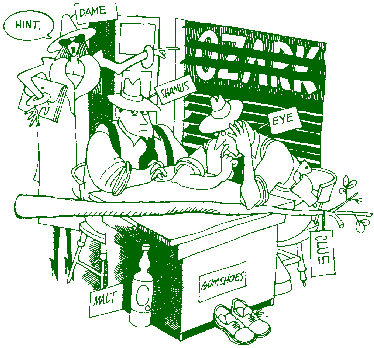Whisky Detectives
 Blenders began to notice itduring the 1970s, and by 1985 it was clear that something had tobe done: almost a quarter of the aged malt whiskies they wantedto use in their blends were turning out to be immature when theywere sampled prior to disgorging. As a result the casks had to bereturned to the warehouses for several years further maturation -at very considerable cost.
Blenders began to notice itduring the 1970s, and by 1985 it was clear that something had tobe done: almost a quarter of the aged malt whiskies they wantedto use in their blends were turning out to be immature when theywere sampled prior to disgorging. As a result the casks had to bereturned to the warehouses for several years further maturation -at very considerable cost.
What was going on? It was impossible to contemplate that thewhisky coming off the still had mysteriously changed, sosomething must be happening - or rather, not happening - duringmaturation.
Had there been an atmospheric change, imperceptible to humans,which disturbed the slumbers of the maturing spirit? Was it to dowith global warming, or holes in the ozone layer, or nucleartesting? Could it be the casks themselves? "But", theblenders reasoned, "we supply our own casks to be filledwith new spirit, and we know the exact provenance of each cask,so how can they be letting us down?...Call Dr. Swan."
Jim Swan is a leading expert on maturation and a pioneer intechniques for analysing flavour in spirits. With the help of agovernment grant, he and his colleague, Jim Gray (an expert onwhisky production), set to work.
"We soon determined that the problem was in the casksthemselves. For some reason a proportion of American oakhogsheads in current use were not maturing the spirit they hadbeen filled with at the rate that we might have expected. Yetthere seemed to be nothing wrong with the casks. They were ingood condition; many were first-fill; their provenance was welldocumented."
Or was it? The researchers noticed that a number of casks hadbeen purchased, at very competitive prices, from a couple ofcooperages. They had been bought as newly re-made hogsheads -i.e. they had been used for maturing Bourbon, but not Scotch. Yetchemical analysis of the wood showed that they had certainly heldScotch - indeed, many had been filled more than once, and somehad contained both malt and grain whisky at different times.
"It turned out that a couple of unscrupulous cooperages(they are no longer in business) had been buying spent casks fromblenders, cleaning them up and selling them on to other blendersas new hoggies. Physical inspection would simply not reveal this.At first we thought we had cracked the problem, then we realisedthat these casks were just the tip of the iceberg: many othershad come straight from Kentucky, and there was no possibilitythat they had been used for Scotch. So Jim Gray and I took ourinvestigation to America.
"The original source of American white oak was the OzarkMountains of Missouri, a remote district with poor soil whichgrew trees too small for most purposes other than making barrels.In recent times the Bourbon industry had begun to source timberfrom further east - more easily accessed, with better soils;where the trees grew faster and provided a greater yield of wood.This was our first clue.
"Our second was the fact that many cooperages nowkiln-dry their timber, rather than leaving it out to season inthe open air for eighteen months, as was the traditional way.Kiln-drying takes a mere twenty-three days.
"Now, kiln dried wood makes no difference to thematuration and flavour of Bourbon, but it has a drastic affect onthe second incumbent - Scotch, Canadian or Irish whisky - whichrelies on the intricate chemistry of the wood itself to achievethe desired results".
In 1991 Doctors Swan and Gray published their definitive Specificationof American Oak Wood for use by the Scotch Whisky Industry.In a nutshell, their recommendation is that at least a quarter ofthe timber used in whisky casks must be slow grown and airseasoned, if the desired end result is to be achieved. Afterpublication, Jim returned to America to see whether thespecification could be met. The Bourbon industry was verysupportive. He was introduced to the few small stave mills whichstill seasoned their timber in the open air. He discovered thatthe only place where the growing conditions were perfect, wherethe trees grew slowly because the soil was poor and the climatearid was - you guessed it - the Ozark Mountains of Missouri.
* Dr. Jim S. Swan is a partner in R.R. Tatlock &Thomson, (Analytical and Consulting Chemists to the Distilling,Brewing, Wine and Water Industries).
If you have comments about thissite, please contact the webmaster. All information in this site © The Scotch Malt WhiskySociety, Edinburgh, Scotland, 1997.
 Blenders began to notice itduring the 1970s, and by 1985 it was clear that something had tobe done: almost a quarter of the aged malt whiskies they wantedto use in their blends were turning out to be immature when theywere sampled prior to disgorging. As a result the casks had to bereturned to the warehouses for several years further maturation -at very considerable cost.
Blenders began to notice itduring the 1970s, and by 1985 it was clear that something had tobe done: almost a quarter of the aged malt whiskies they wantedto use in their blends were turning out to be immature when theywere sampled prior to disgorging. As a result the casks had to bereturned to the warehouses for several years further maturation -at very considerable cost.